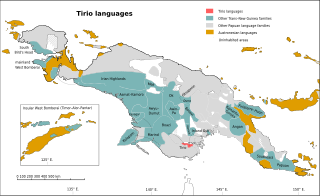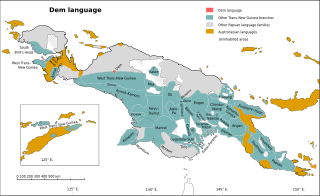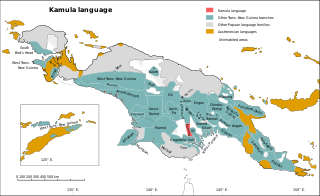Related Research Articles

The Mantion–Meyah or (South) East Bird's Head languages are a language family of three languages in the "Bird's Head Peninsula" of western New Guinea, spoken by all together 20,000 people.

The Eastern Trans-Fly languages are a small independent family of Papuan languages spoken in the Oriomo Plateau to the west of the Fly River in New Guinea.

The Yawa languages, also known as Yapen languages, are a small family of two closely related Papuan languages, Yawa and Saweru, which are often considered to be divergent dialects of a single language. They are spoken on central Yapen Island and nearby islets, in Cenderawasih Bay, Indonesian Papua, which they share with the Austronesian Yapen languages.
Mailu, or Magi (Magɨ), is a Papuan language of Papua New Guinea.

Western Pantar, sometimes referred to by the name of one of its dialects, Lamma, is a Papuan language spoken in the western part of Pantar island in the Alor archipelago of Indonesia. Western Pantar is spoken widely in the region by about 10,000 speakers. Although speakers often use Malay in political, religious, and educational contexts, Western Pantar remains the first language of children of the region, and is acquired to some extent by immigrants.
Adzera is an Austronesian language spoken by about 30,000 people in Morobe Province, Papua New Guinea.
Amanab is a Papuan language spoken by 4,400 people in Amanab District, Sandaun Province, Papua New Guinea.

The Marind–Yaqai (Marind–Yakhai) languages are a well established language family of Papuan languages, spoken by the Marind-anim. They form part of the Trans–New Guinea languages in the classifications of Stephen Wurm and Malcolm Ross, and were established as part of the Anim branch of TNG by Timothy Usher.
The Dani or Baliem Valley languages are a family of clearly related Trans–New Guinea languages spoken by the Dani and related peoples in the Baliem Valley in the Highland Papua, Indonesia. Foley (2003) considers their Trans–New Guinea language group status to be established. They may be most closely related to the languages of Paniai Lakes, but this is not yet clear. Capell (1962) posited that their closest relatives were the Kwerba languages, which Ross (2005) rejects.

Fasu, also known as Namo Me, is one of the Kutubuan languages of New Guinea.

The Tirio languages are a family of Trans–New Guinea languages in the classification of Malcolm Ross. The Tirio languages have about 40% of their lexicon in common.
Momuna (Momina), also known as Somahai, is a Papuan language spoken in Yahukimo Regency, Highland Papua and Asmat Regency, South Papua, Indonesia.

The Tonda languages form a branch of the Yam language family of southern New Guinea. There are over 10 languages.

The Yam languages, also known as the Morehead River languages, are a family of Papuan languages. They include many of the languages south and west of the Fly River in Papua New Guinea and Indonesian West Papua.
Mpur is a language isolate spoken in and around Mpur and Amberbaken Districts in Tambrauw Regency of the Bird's Head Peninsula, New Guinea. It is not closely related to any other language, and though Ross (2005) tentatively assigned it to the West Papuan languages, based on similarities in pronouns, Palmer (2018), Ethnologue, and Glottolog list it as a language isolate.
Abun, also known as Yimbun, Anden, Manif, or Karon Pantai, is a Papuan language spoken by the Abun people along the northern coast of the Bird's Head Peninsula in Sausapor District, Tambrauw Regency. It is not closely related to any other language, and though Ross (2005) assigned it to the West Papuan family, based on similarities in pronouns, Palmer (2018), Ethnologue, and Glottolog list it as a language isolate.

Morori is a moribund Papuan language of the Kolopom branch of the Trans–New Guinea family. It is separated from the other Kolopom languages by the intrusive Marind family. All speakers use Papuan Malay or Indonesian as L2, and many know Marind.

Dem is a divergent Papuan language of West New Guinea. Although Palmer (2018) leaves it unclassified, it was tentatively included in the Trans–New Guinea family in the classification of Malcolm Ross (2005), and Timothy Usher ties it most closely to Amung.

Kamula is a Trans–New Guinea language that is unclassified within that family in the classification of Malcolm Ross (2005). Noting insufficient evidence, Pawley and Hammarström (2018) leave it as unclassified.
Urat is a Torricelli language spoken by a decreasing number of people in Papua New Guinea.
References
- ↑ Kombio at Ethnologue (18th ed., 2015) (subscription required)
- ↑ Foley, William A. (2018). "The Languages of the Sepik-Ramu Basin and Environs". In Palmer, Bill (ed.). The Languages and Linguistics of the New Guinea Area: A Comprehensive Guide. The World of Linguistics. Vol. 4. Berlin: De Gruyter Mouton. pp. 197–432. ISBN 978-3-11-028642-7.